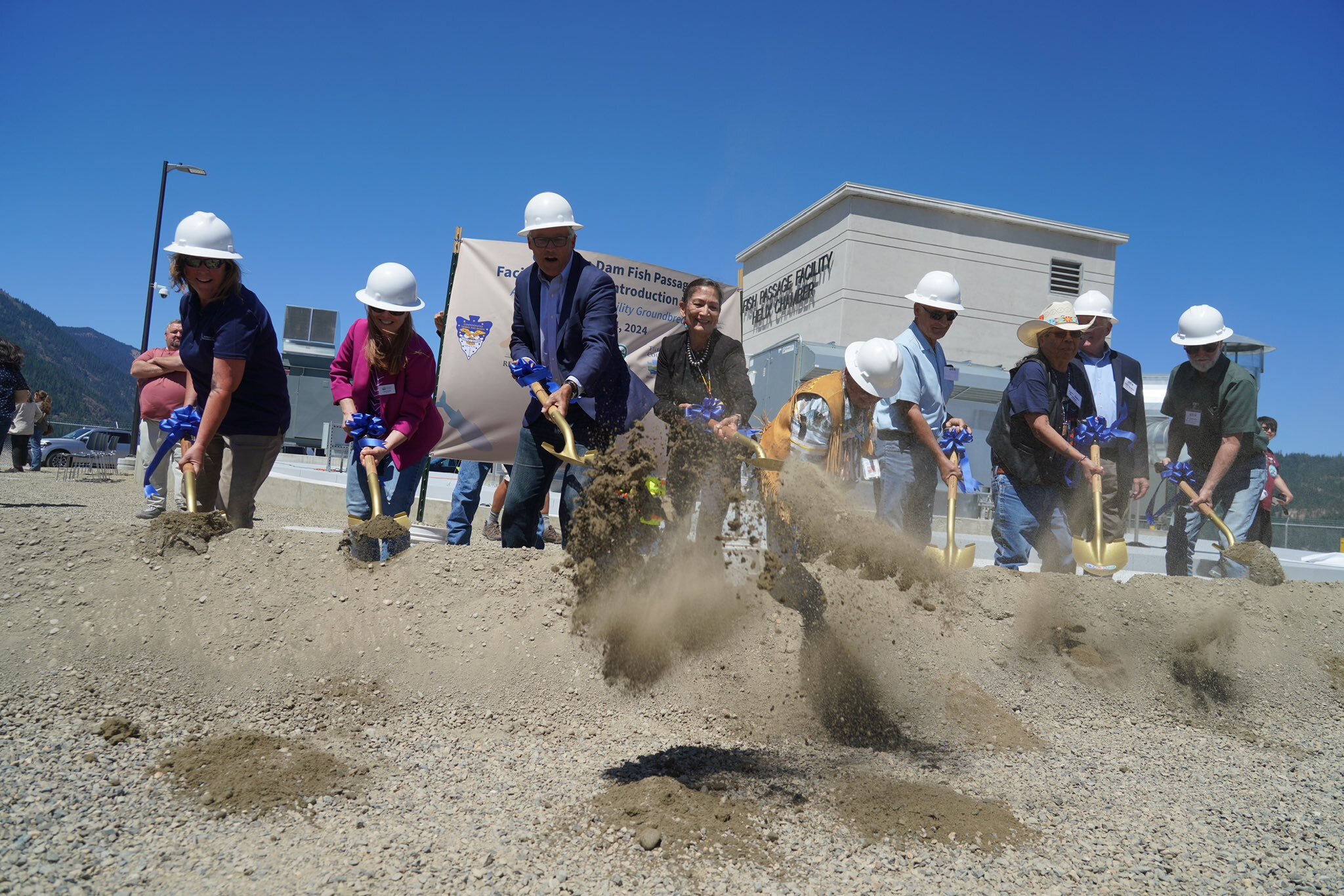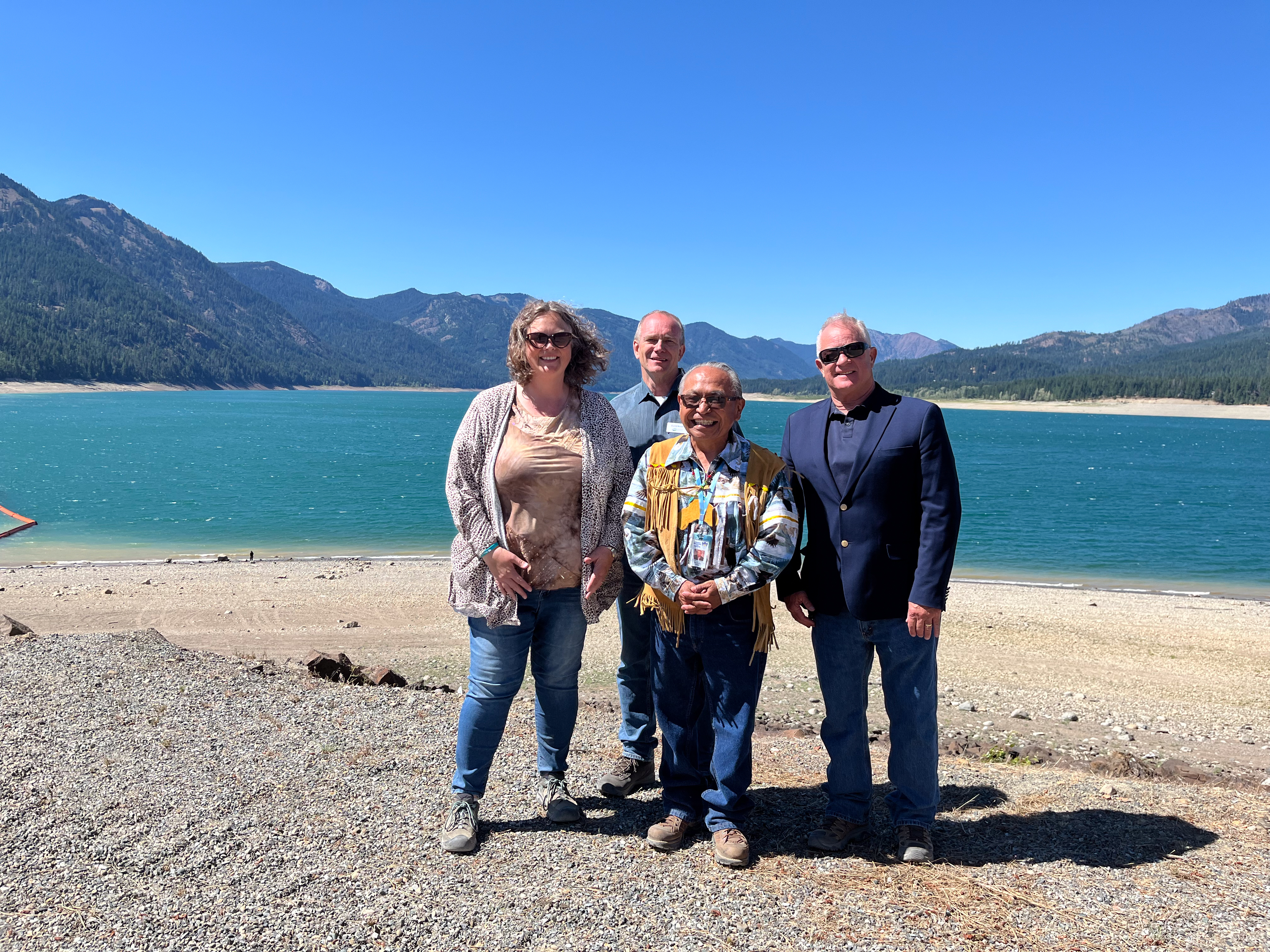
The juvenile fish passage helix chamber, which works like an eight-story-deep spiraling water slide for young salmon, in construction during the summer of 2020.
In July, we joined our partners in the Yakima Basin Integrated Plan to celebrate completing the plan’s biggest undertaking so far: the Cle Elum juvenile fish passage facility.
This milestone is one part of a larger project at Cle Elum Dam that will improve access to 30 miles of river habitat. It is projected to help increase sockeye return into the Yakima Basin fivefold, from 20,000 to 100,000 each year.
Last year marked the 10-year anniversary of the state’s initial investment in the Integrated Plan, making this celebration a timely closeout to the plan’s first phase – and helping to lay a solid foundation for the next 10 years and beyond.
Innovative engineering
The juvenile fish passage facility features a first-in-the-nation helix structure – basically an eight-story-deep spiraling waterslide – that allows young salmon from the reservoir to pass through the dam and downstream into the Cle Elum River. With the helix, they can do so more often and at the right time to survive their migration to the ocean.
The helix looks and works like a parking structure ramp. The reservoir level determines which intake opening fish enter through (left side of the diagram). They exit at the bottom of the helix (bottom right of the diagram) into the Cle Elum River.
Fish travel down the helix tail first, the same way they naturally travel downstream, at a rate up to 25 miles per hour. While that may seem dangerously fast, the structure is designed to minimze turbulence and create a smooth ride so the fish emerge unharmed. Their journey through the dam takes about a minute, a short but critical stop on their way to the ocean.
Next spring, we expect to send migrating salmon through the helix for the very first time.
Bringing the salmon home
Integrated Plan partners break ground on the upstream adult collection facility. Left to right: Bureau of Reclamation PNW Regional Director Jennifer Carrington, Ecology Director Laura Watson, Gov. Jay Inslee, Interior Secretary Deb Haaland, Yakama Nation Chairman Gerald Lewis, Roza Irrigation District Board Member Ric Valicoff, Leon Louis (Lower Similkameen Indian Band, Syilx Nation), Department of Agriculture Director Derek Sandison, Department of Fish and Wildlife Commissioner Steve Parker.
Immediately after opening the new helix structure, the Integrated Plan broke ground on the second part of the Cle Elum fish passage project, expected to open in late 2026 or early 2027.
This next and final facility is an upstream adult fish collection structure at the base of Cle Elum Dam. Once completed, it will allow fully grown salmon to remain in the river longer as they return to spawn in the upper reaches of the Yakima Basin. Instead of being collected at the Roza Dam and traveling almost 60 miles by truck, fish collected at the new facility will only need to be trucked a thousand feet over the Cle Elum Dam.
Together, both the downstream juvenile and upstream adult facilities play a critical role supporting the sockeye life cycle and ultimately bringing salmon back home to the basin.
Decades in the making
Ecology with Yakama Nation Chairman Gerald Lewis. Left to right: Melissa Downes (Office of the Columbia River), David Bowen (Central Region Office), Chairman Lewis, Tom Tebb (Office of the Columbia River).
Planning for the Cle Elum fish passage began in 2010, with construction under way by 2015. This effort took years of close collaboration among the Yakama Nation, the U.S. Bureau of Reclamation, the Washington Department of Fish and Wildlife, and Ecology.
None of this was possible without the leadership of the Yakama Nation, which spent years reintroducing sockeye. Completing the juvenile fish passage facility is the culmination of the Nation’s efforts and responsible stewardship of natural resources, in addition to many years of cooperation, investment, and hard work from other Integrated Plan partners.
This progress is also possible thanks to sustained investments from the state Legislature and Congress, totaling $750 million since 2013. Over the years, that funding has supported successful water storage, fish passage, habitat, conservation, and irrigation efficiency projects – which all contribute to the Integrated Plan’s proven track record as a national leader in water supply work.
Celebrating progress
Yakama Nation Chairman Gerald Lewis addresses the crowd before the ribbon cutting for the juvenile fish passage facility.
The Cle Elum fish passage project – and the Integrated Plan itself – has strong support from Gov. Jay Inslee and U.S. Interior Secretary Deb Haaland. Both joined over 200 guests to celebrate the opening of the new juvenile facility on July 24.
The project also earned praise from Washington’s congressional delegation. Sens. Patty Murray and Maria Cantwell and Reps. Dan Newhouse and Kim Schrier all commended the landmark occasion.
At Ecology, we’re excited about this moment as a snapshot in time, showing us how much we’ve accomplished improving water resources and restoring ecosystems in the Yakima Basin. We’re grateful to all the supporters of the Integrated Plan. With their help, we can continue working to protect water for all the people, farms, and fish that call the Yakima Basin home – for this generation and the next.
The Yakima Basin Integrated Plan is a 30-plus-year, multi-agency strategy to secure water for communities, farms, and fish. From the start, the Integrated Plan emerged as a national leader in collaborative, innovative water supply solutions. Without its investments, recent droughts would have created even greater hardships for Washington communities. Visit the website or read the 2023 annual recap for more information.





